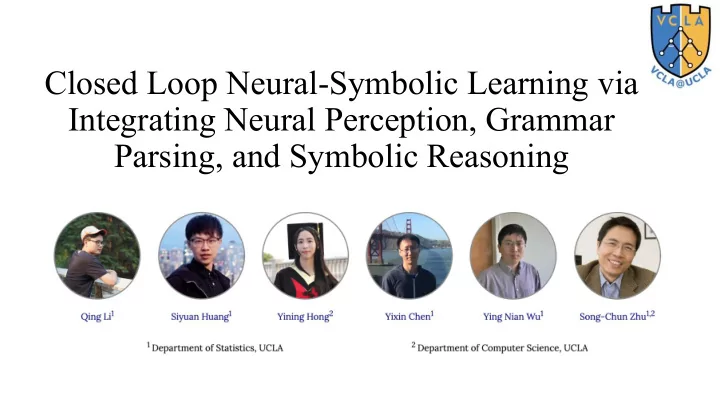

Closed Loop Neural-Symbolic Learning via Integrating Neural Perception, Grammar Parsing, and Symbolic Reasoning
Motivation NS-RL Neural Symbolic Input Prediction Error Network Reasoning Ground Truth ✘ ✘ ✔ Forward pass Conditional Backward pass Backward pass 2
How does human do this task? 29 14 12 27 2 + 4 3 9 4 1. Always generate a valid formula Prior knowledge 2. Back-trace the error in the reasoning tree Abductive reasoning 3. Find the error source and propose a fix 4. Update the perception 3
Contributions • Grammar to bridge neural network and symbolic reasoning • NGS: Neural perception + Grammar parsing + Symbolic reasoning • Back-search • Mimic human’s ability to learn from failures via abductive reasoning • A new benchmark HWF for neural-symbolic learning • Hand-written Formula Recognition with Weak Supervision 4
Hand-written Formula Recognition (HWF) Input Latent Output Input Weakly-supervised! 5
NGS ‘0’ ‘1’ … ‘9’ ‘+’ ‘-’ ‘*’ ‘/’ Neural 1 Network … Grammar ‘6’ ‘-’ Parsing ‘2’ ‘*’ ‘8’ -10 Symbolic Reasoning 16 6 - 2 * 8 6
Forward Pass (Inference) • 7
Forward Pass (Inference) Neural Perception Grammar Parsing Symbolic Reasoning 8
Backward Pass (Learning) • Assumptions • Grammar and Symbolic reasoning are perfectly designed by hand, based on our domain knowledge. • Only the parameters of neural network need to be learned. • Gradient descent cannot be applied directly • Grammar parsing and symbolic reasoning are non-differentiable. 9
1-step Back-search (1-BS) • Top-down search is guided by the bottom-up perception probability • Dynamic Programming + Priority Queue 10
A running example for 1-BS 14 29 2+3*9 12 27 2 + 4 2+3*4 3 * 9 4 11
Queue Queue Queue Queue Pop Pop Push 14 Push 12 27 2 + Push Pop Pop 3 * 9 12
Why can BS be better than RL? • Learning as Maximum Marginal Likelihood • REINFORCE as Rejection Sampling • m-BS as MCMC sampling • Metropolis-Hastings sampler 13
Learning as Maximum Marginal Likelihood Marginal likelihood Monte Carlo sampling 14
Posterior distribution 15
REINFORCE as Rejection Sampling • Target distribution: • Proposal distribution: • Rejection sampling: 1. Sample z from 2. If reject else accept 16
m-BS as MCMC Sampling • m-BS is a Metropolis-Hastings sampler for [Proof in Sec. 3.2.3] 17
Experiments • Hand-written Formula Recognition • Neural-symbolic VQA 18
Hand-written Formula Recognition • Dataset • Built from the CROHME challenge • 10k expressions for training, 2k expressions for testing • Evaluation • Symbol accuracy, Result Accuracy • Models • NGS-RL, NGS-RL-Pretrained • NGS-MAPO*, NGS-MAPO-Pretrained *Pretrain NN on a set of fully-supervised data • NGS-BS *Memory-Augmented Policy Optimization [1] [1] Liang, Chen, et al. "Memory augmented policy optimization for program synthesis and 19 semantic parsing." Advances in Neural Information Processing Systems . 2018.
Learning curves 1. NGS-RL fails without pretraining 2. NGS-MAPO works without pretraining but takes a long time to start improving (cold start). 3. Both NGS-RL and NGS-MAPO have noisy learning curves. 4. NGS-BS doesn’t suffer from the cold start. 5. NGS-BS converges much faster and the learning curve is smooth. 6. NGS-BS achieves nearly perfect accuracy. 20
Data efficiency 21
Examples 22
Examples 23
Neural Symbolic VQA • NS-VQA on CLEVR [1] • Replace the Seq2Seq question parser with Pointer Network [1] Yi, Kexin, et al. "Neural-symbolic VQA: Disentangling reasoning from vision and language understanding." NeurIPS 2018. 24
Examples 25
Conclusions & Future works • RL is inefficient for weakly-supervised neural-symbolic learning. • Back-Search boosts neural-symbolic learning. • m-BS is a Metropolis-Hastings sampler for the posterior distribution. • Back-search might be applied to a variety of neural-symbolic tasks, such as semantic parsing, math word problem. • How to incorporate grammar learning and logic induction is still an open problem. 26
Thank you! Project: https://liqing-ustc.github.io/NGS/ Code: https://github.com/liqing-ustc/NGS 27
Recommend
More recommend